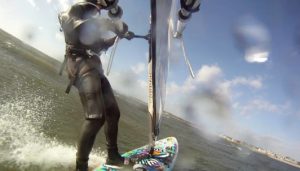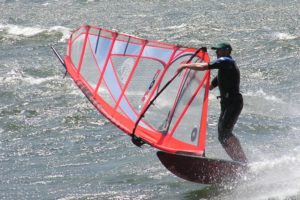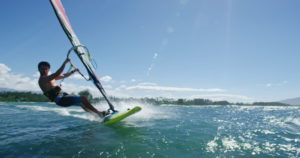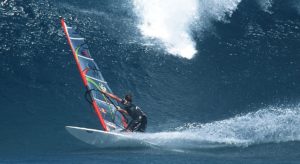Jumping a windsurfer on wind blown chop is a spectacular trick. It can also be done on flat water.
Chop jumping on a windsurfer is the technique of getting the board completely out of the water. It is possible to chop jump in completely flat water.
Setting Up For a Jump
So how do those hot-shots get the board miraculously flying into the air with seemingly the greatest of ease? A small wake of a boat or a wind blown chop always helps. Speed and weight – both the sailor and the rig – is also crucial.
It is best to start with a fair sized chop, the normal slop that’s thrown up in the face of a twenty knot wind will usually do. The board needs to be going at full throttle on a broad reach.
As the chop will usually be running across the direction of travel, the board will have to turn into the wave face. This is done by digging in the windward rail.
Leaving the Water
When the board hits the wave, dig the back of the board in so the power of the sail is driving the board upwards. At the exact point when the fin is at the top of the small chop, pull up on the boom and bend the knees. This will jerk the back of the board out of the water and, as the front is already a few feet up, the whole board should lift clear of the water.
Landing After a Chop Jump
To land, get the front of the board entering the water first, followed by the tail, and land running with the wind. This will stop spinout and be a lot easier on the equipment.
Jumping a Windsurfer in Flat Water
It is possible to jump in dead flat water, as long as the board is going fast. First build up speed, then pick a spot and pretend there is a wave there. Push down on the back to get the nose up, then pull on the boom, bend the knees and the board should lift out of the water. This action is the same as jumping on a small chop; just more effort is required on the legs and stomach muscles to pull the board out of the water.
Chop Jumping Stresses Equipment
Chop jumping puts tremendous stresses on two parts of a board. The first is the fin. The action of jerking the board out of the water by bending the knees causes the fin to leave the water sideways. When travelling at around fifteen knots this puts a great deal of pressure on the fin and fin box. If the fin has even the slightest sideways movement in it, it may give way leading to a spectacular wipeout on landing.
The other part of the board to watch when chop jumping is the area where the feet land. An adult sailboarder falling repeatedly, even half a metre, onto an area the size of a heel can damage a board quite quickly – cracks in glass and epoxy boards and heel sized craters in polyethylene. This can be overcome to a certain extent with a set of good quality rad pads.
For an excellent introduction to jumping in the surf, chop jumping is the way to go. If a sailboarder can get a metre or so in the air off a little boat wake imagine the height off a three metre giant in the Pacific. The sky’s the limit!!










